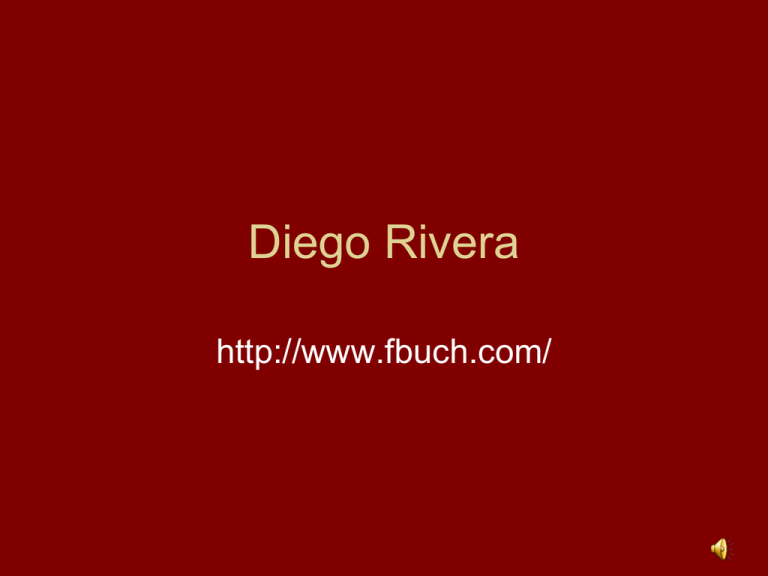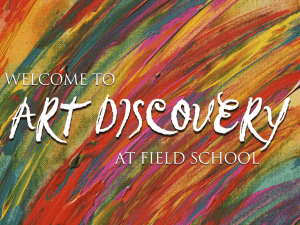Diego Rivera - El Mundo de Birch
advertisement

Diego Rivera http://www.fbuch.com/ “ “ An artist is above all a human being, profoundly human to the core. If the artist can’t feel everything that humanity feels, if the artist isn’t capable of loving until he forgets himself and sacrifices himself if necessary, if he won’t put down his magic brush and head the fight against the oppressor, then he isn’t a great artist.” Diego Rivera Why should we study Diego Rivera? • The answer is simply that Rivera was one of the most influential artists of the twentieth century. He was a legend in his own time. The effect of his art can be compared to that of Michelangelo. We can learn about history and ourselves through the murals created by Diego Rivera whose dream was to be the artist of the Americas. • http://www.yale.edu/ynhti/curriculum/units/1999/2/99.02.06.x.html Diego Rivera was born December 8, 1886, in Guanajuato, Mexico, to Diego and Maria Barrientos Rivera. His twin brother, Carlos, died 2 years later. By the age of 2, he was already drawing and his father set up a studio for him before he could even read. They lived in Guanajuato until 1892, when they moved to Mexico City. Guanajuato La calle De Avila 1908 At the age of ten Diego Rivera was doing well in school. Passionately fond of drawing from an early age, he started taking evening painting classes at the San Carlos Academy. In 1898 he enrolled there as a full time student, and in 1906, at the annual show, he exhibited for the first time, with 26 works. At age twenty Diego Rivera was well established as a painter. House Over the Bridge 1909 Diego's father, a liberal and anti-religious man, was on the City Council in Guanajuato. Diego's two aunts, who lived with the family, were rather religious. Diego was interested in military issues, and he was especially fascinated by the Russian army and the conflict it was facing; the Tsar and the Orthodox Church versus Marxist Revolutionaries. Diego Rivera, self portrait 1907 In 1907 Diego went to Spain. He travelled extensively in Spain, and also went to France, Belgium, and England. In Brussels in 1909 he metAngelina Belhoff, a slender, blond young Russian painter, a kind, sensitive, almost unbelievably decent person, and she became Diego's partner for the next twelve years. They travelled together, mostly in Europe, and spent much time in Paris, where Diego Rivera participated in several exhibitions. During this time they had many friends, and several of these were Russians. Diego, 1910 By 1913 Diego Rivera was fascinated by the early cubist movement, led by celebrated Spaniard Pablo Picasso, and started experimenting with cubism himself. By 1914 Diego was viewed as one of the more interesting members of the Cubist movement, one of the avant garde. Diego was a great admirer of Pablo Picasso, and they became close friends. Diego confided that in Paris, when they were by themselves, they would have the best of times saying things about other painters they would never tell anybody else! Portrait of Two Women Sailor at Breakfast 1914 Portrait of Ramón Gomez de la Serna, 1915 The Architect 1915 The First World War broke out in Europe. In Mexico the revolutionary folk hero Emiliano Zapata battled to return the land to the people. It was in these years Diego Rivera became a revolutionary himself. His friend, David Sternberg, the Soviet People's Commissar of Fine Arts invited him to Russia, but Diego felt called to return to Mexico and returned in 1921. Emiliano Zapata Pancho Villa, revolutionary del Norte, Emiliano Zapata, revolutionar del Sur. Zapatista Landscape: The Guerrilla An expression of his Mexican heritage and the growing call of the Mexican Revolution surrounding Diego. 1915 Motherhood: Angelina and the Child Diego 1916 Self Portrait 1918 In addition to his painting activities, which by now were focused increasingly on murals, Diego Rivera participated in the founding of the Revolutionary Union of Technical Workers, Painters and Sculptors in the autumn of 1922, and later that year he joined the Mexican Communist Party. In the years that followed, Diego was engaged by The (Soviet) Revolution, as his signature on the mural The Agitator illustrates: He became convinced that a new form of art should respond to “the new order of things … and that the logical place for this art … belonging to the populace, was on the walls of public buildings.” MURAL O FRESCO Returning in 1921 to Mexico, he painted, with the assistance of younger artists, large murals dealing with the life, history, and social problems of Mexico,in the Preparatory School and the Ministry of Education in Mexico City and the Agricultural School of Chapingo. To the peasants and workers he becamea sort of prophet. http://www.factmonster.com/ce6/people/A0842002.html First Mural, 1922-1923 The Creation Day of The Dead 1924 Ministry of Education Burning of the Judases 1924 Ministry of Education La Molendera 1924 Flower Day 1925 The Agitator 1926 In the autumn of 1927 Diego took a trip to the Soviet Union, as a member of an official delegation of Mexican Communist Party representatives, to take part in the tenth anniversary celebrations of the October Revolution. Diego's interest In the Workers Movement clearly show in the mural below, which shows Frida Kahlo, Diego's third wife and longtime (1929 to 1954) partner, handing out guns to workers who have decided to fight: 1929 Diego and Frida 1930 In the United States he painted frescoes in the luncheon club of the Stock Exchange and in the Fine Arts Building, both in San Francisco, and murals in the Detroit Institute of Arts, giving his interpretation of industrial America as exemplified in Detroit. http://www.factmonster.com/ce6/people/A0842002.html Frozen Assets 1931 Allegory of San Francisco 1931 Diego and Frida 1932 In 1933 Diego started work on a mural, Man at the Crossroads, in Radio City in the Rockefeller Center in New York. However, a conflict arose over a portrait of Lenin, the first leader of the Soviet Union, and the mural was chipped off the wall and destroyed February 9, 1934. The picture below was shot before the mural was broken into into pieces: Diego was determined to complete the mural, but in a different place, and after doing several murals at the New Workers School, including the Workers of the Worl panel, he left the US, after working a few years in California, Detroit and New York. Then he did a new version of the Crossroads mural, called Man, Controller of the Universe, in Mexico City. Below is a detail: To the right of Lenin, the founder of the Soviet Union, we spot Leon Trotsky, another principal leader of the Russian Revolution. In his later years, Leon moved to Mexico, where he was a close friend of Diego. Epic of the Mexican People - Mexico Today and Tomorrow, 1934-35, Palacio Naciona Detail from the "Man, Controller of the Universe" mural in Mexico City, painted in 1934. The man in the center is Lenin, symbolically clasping the hands of a black American, a white Russian soldier, and a worker, as allies of the future. The mural is a reconstruction of another mural in the Rockefeller Center in Radio City, which was destroyed after a major political fracas. Basically, it was politically unacceptable to depict Lenin,the preeminent founder of the Soviet Union, as the center of the inevitable alliance between the Russian and American (people). Frida Kahló shared Diego Rivera’s revolutionary feelings, shown here demonstrating in 1936. Diego Rivera, Leon Trotsky, and Andre Breton, 1938 Diego Rivera remained loyal to the revolutionary cause all his life, and below we see him, speaking to the Mexican Communist Party, late in his life. Lupe Marin, Diego's second wife (1922-27), 1938. Las Manos De Dr. Moore 1940 Escuela de San Francisco 1940 The Great City of Tenochtitlan, 1945, National Palace, Mexico City Retrato de Dolores Olmedo 1955 1949 El estudio del pintor 1954 In 1956 the artist went to Moscow for an operation. Several months before his death he announced his affiliation with the Roman Catholic Church. El desfile del Primero de mayo de Moscu 1956 I am Diego. I paint what I see. 1886-1957








